This post may contain affiliate links, which means we may receive a commission from purchases made through these links. See our affiliate disclaimer.
After choosing the right dog food, you might be looking for a nice, sturdy feeding bowl for your dog. Well, here we help you do just that — pick a dog bowl. We start with a few simple features to consider, then we go into the pros & cons of the common types of dog bowls.
Plus the big question — stainless steel or ceramic? — we guide you through below.
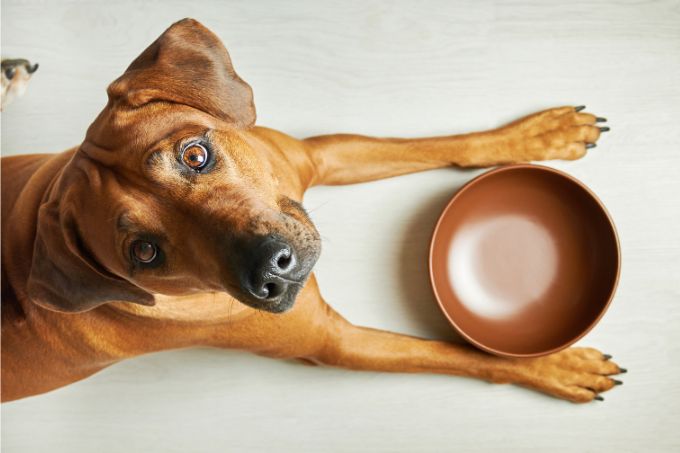
Dog bowl features to consider
Material
This is perhaps the most important thing to consider, and probably the reason you’ve come to this article. Most bowls will be made from one of 3 materials: stainless steel, ceramic or plastic. To lesser extents, you can find bowls made from polyester or silicone — usually bowls intended for travel use.
We provide the pros & cons for each of these bowl types below, but here’s the spoiler version: we recommend stainless steel bowls for most dogs.
You might have noticed we didn’t include plastic bowls in our “big question” above — stainless steel or ceramic? — and that’s because we don’t recommend plastic bowls.
Bowl size
Dog bowls usually come in at least 3 sizes — small, medium & large — roughly corresponding to 8oz, 16oz and 32oz. It won’t be the same for all dog bowls, but we can use this as a rough guide.
It sounds tailored to dogs by their sizes. Small bowls for small dogs, for example. But we recommend going up a size. For small dogs, get a medium-sized (16oz) bowl. The extra space will help ensure that your dog doesn’t make a mess while eating. Dogs get pretty excited while eating, and their snouts can knock some food or liquids right out of a smaller bowl.
For large dogs, you can pick the largest available bowl (at least 32oz) — extra space won’t hurt.
Non-slip bottom
You want to make sure the dog bowl you select has a non-slip bottom, otherwise it’ll be sliding all over the place while your dog is trying to lick up the last of his food. It’s cute to watch, but this will be a frustrating experience for your dog. Rubber around the rim of the bowl or silicone pads on the bottom are the most common types of non-slip. If your bowl comes in a holder, make sure the holder is non-slip.
We included this feature in its own section because it’s such a boost in quality of feeding for dogs. The good news is most bowls will have this feature, you just have to keep an eye out for it.
Alternatively, you can keep your dog’s bowl on a non-slip mat. It keeps the feeding area tidier and makes clean up that much easier.
Special functions
Dog bowls with special functions have become more & more common. Collapsible bowls that you can whip out during hikes with your dog. Automatic feeders that dispense food at scheduled times while you’re at work. We go into detail for these types of dog bowls & more in the sections below.
Ease of cleaning
Stainless steel bowls & ceramic bowls are generally easy to clean, and a lot of them will be dishwasher-friendly too (mostly top rack). Plastic & silicone bowls might need a bit of elbow grease, while slow feeders will be more challenging due to the grooves in the bowl.
Ease of cleaning is just some thing to keep in mind, but the important takeaway here is to clean your dog’s bowls regularly.
Your dog’s size
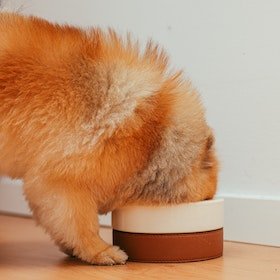
Large dogs can have a difficult time keeping their necks lowered for the duration of their feeding. Dogs with short snouts (brachycephalic), like bulldogs, pugs & shih tzus for example, may have a hard time breathing while eating if their bowls are too deep.
These are a couple of reasons it’s a good idea to consider your dog’s size when selecting a bowl. If you have the space for it, we recommend elevated bowls for large dogs, and bowls that aren’t too deep for most dogs.
Stainless steel dog bowls
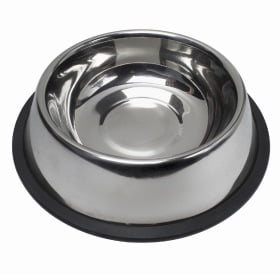
Stainless steel bowls are just about the most common dog food bowls you can find. They come in multiple sizes, are easy to clean, and often dishwasher safe (don’t forget to check the label for instructions!).
They’re also non-porous, which means the surface is sealed so liquids & solids can’t get in. Non-porous surfaces are more hygienic because bacteria can’t get into them & grow in colonies.
What we don’t like about them: they may still sometimes rust if left outdoors. They don’t come in different colors or designs.
However, they’re extremely durable and inexpensive. Which is why stainless steel is our pick for best dog bowls for most dogs. Just make sure they have a non-slip rubber bottom, and we also recommend one that is shallow & wide.
Ceramic dog bowls
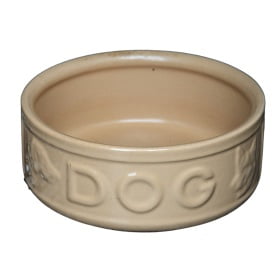
Ceramic bowls are stoneware or earthenware that are glazed, so they’re non-porous and easy to clean (but not all are dishwasher safe). They come in a variety of sizes, colors and designs. You can even find ones that are handmade. Best for stylish fur parents, who want their dog bowls to match their well-designed homes. One thing to keep in mind is that these bowls can get pretty heavy.
What we don’t like about them: they’re brittle, so they will break if dropped. They are also prone to cracking & chipping, and it’s unsafe to use cracked or chipped ones. One needs to be extra careful with these pieces that can sometimes get expensive.
We include glass bowls under the ceramic category because they have similar characteristics. Glass bowls however break & chip more easily than ceramic ones. They also shouldn’t be left outdoors.
Plastic dog bowls
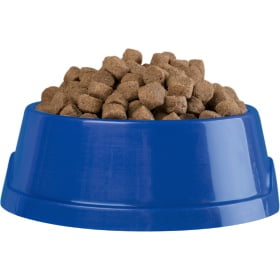
Plastic bowls are easy to find and they’re more affordable than the other types of bowls mentioned here. They won’t break if dropped, are easy to clean, and dishwasher safe. They come in a wide variety of sizes and colors.
What we don’t like about them: they become porous if scratched or chewed, so they can retain bacteria and smells that many dogs become sensitive to over time. They’ll need to be replaced every few months. Cheaper plastic products may contain harmful chemicals that could leech onto your dog’s food, or worse, cause a blockage in your dog’s stomach.
Best for fur parents on a strict budget, but even then we recommend finding one that is BPA- and phthalate-free. Safety first!
Travel dog bowls
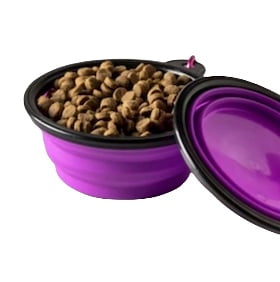
Travel dog bowls are an essential doggy item if you like to bring your dog along on your outdoor activities. The collapsible kind is a popular choice — these would work well for shorter trips to the park for example, so your dog can have a drink whenever he needs it.
They’re commonly made of polyester, silicone or even lined fabric. These bowls are inexpensive, easy to clean and quite durable. You can toss them in your doggy bag and forget about them until the next time you need them. Best for the active dog.
What we don’t like about them: polyester and silicone bowls aren’t intended for daily use, they’re more of an extra bowl you’ll have for occasional use.
Elevated dog bowls
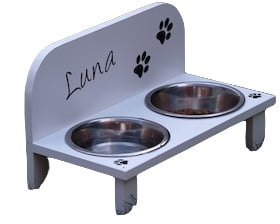
Elevated dog bowls aren’t made from a special type of material, rather they’re an added function for extra comfort during feeding. For the 5 or so minutes that your dog is chowing down, his head is bent over to reach the bowl. This can cause neck strain, especially for taller dogs or older dogs with arthritis, for example.
They usually come as a pair of bowls, mounted on a wooden or plastic stand. The designs are often minimal, which makes the feeding area look tidier in our opinion. Best for large dogs & older dogs with arthritis, but most dogs will benefit from the added comfort.
What we don’t like about them: these bowls are usually more expensive, and can take up space.
Slow feeder dog bowls
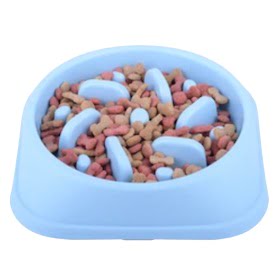
This type of bowl has the special function of preventing dogs from eating their food too quickly. They have a design of ridges that look like a maze, so dogs will have to eat around the ridges instead of having easy access to the food. This slower pace of eating is mentally stimulating for dogs, and can lead to a more satisfied feeling after the meal. Best for dogs who eat too quickly.
Why do want to prevent dogs from eating too quickly? It carries the risks of choking, indigestion, or bloating. There are also some other risks that are less common. If you notice your dog makes gagging sounds while scarfing down his food, or that he’s extra gassy after meals, this type of bowl might be for him.
What we don’t like about them: they’re usually made of plastic, and they’re harder to clean.
Automatic feeders
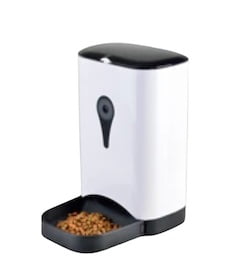
Automatic feeders are just plain dog bowls, but with a dispenser attached that automatically refills the bowls. The more common type of dispenser keeps the bowl full at all times — we refer to these as gravity feeders. This means your dog will always have access to his food (a practice known as free feeding), and could be at risk of eating too much & gaining weight.
There are feeders that are programmable — they dispense a measured amount of food, on a schedule that can be set by the user. This can be helpful for fur parents who work long hours. Best for the busy fur parents, and we recommend the programmable kind instead of the gravity feeding kind.
What we don’t like about them: they usually don’t work with wet food, and they’re often made of plastic. There will be extra parts to clean.
Water bowls
The dog bowls discussed in the above sections will generally work as water bowls too; this section is to highlight water bowls with added functions.
Before we dive into that, we want to mention here that we do recommend each dog have two separate bowls — one for food & one for water. It can be the exact same bowl, two inexpensive stainless steel bowls, for example. We find having a separate bowl for water builds better drinking habits for dogs.
Water dispensers
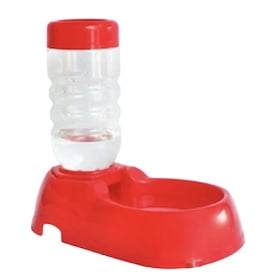
Just like the automatic feeders above, water dispensers are just plain dog bowls with a dispenser attached. They keep the water bowls full at all times, ensuring that your dog will always have drinking water available. They can also help build healthy drinking habits, and more importantly can prevent dehydration.
If you work long hours, or aren’t able to keep an eye on your dog’s daily water intake, this device can be a life-saving measure. Best for busy or forgetful fur parents, especially during the summer months.
What we don’t like about them: they’re often made of plastic, and it can be easy to forget to clean the bowls regularly.
Water fountains
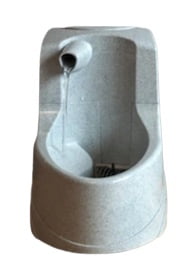
Water fountains also ensure that dogs will have a steady supply of drinking water, but they have the added function of keeping the water circulating, which keeps the water fresh. It’s a fun product, but there is a learning curve and not all dogs will be drawn to this manner of drinking. Best for dogs that enjoy running water, such as faucets or water hoses, for example.
What we don’t like about them: not all dogs will take to these fountains.
That covers all the most common types of dog bowls available on the market today! Now that you’re an expert on dog bowls, why not have a look at our guide to picking dog food?


I’m glad you’re enjoying our content, Rylie – thank you!